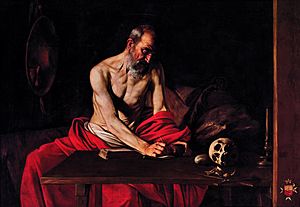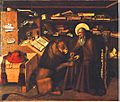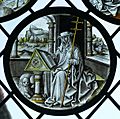Jerome facts for kids
Quick facts for kids SaintJerome |
|
|---|---|
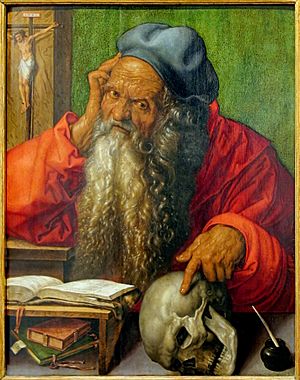
St. Jerome in His Study by Albrecht Dürer, 1521
|
|
| Doctor of the Church | |
| Born | c. 342–347 Stridon (possibly Strido Dalmatiae, on the border of Dalmatia and Pannonia |
| Died | 30 September 420 (aged approximately 73–78) Bethlehem, Palaestina Prima |
| Venerated in | Orthodox Church Roman Catholic Church Oriental Orthodox Church Anglican Communion Lutheranism |
| Major shrine | Basilica of Saint Mary Major, Rome, Italy |
| Feast | 30 September (Latin Catholic Church) 15 June (Eastern Orthodox Church) |
| Attributes | Lion, cardinal attire, cross, skull, trumpet, owl, books and writing material |
| Patronage | Archaeologists; archivists; Bible scholars; librarians; libraries; school children; students; translators; Morong, Rizal; Dalmatia, against anger |
| Influences | Paula of Rome, Plato, Vergil, Cicero, Isocrates, Philo, Seneca the younger, Eusebius, Paul the Apostle, Ezra the scribe, Onkelos |
| Influenced | Virtually all of subsequent Christian theology, including Catholic, Eastern Orthodox and some Protestant |
Jerome (born between 342 and 347 AD – died September 30, 420 AD), also known as Jerome of Stridon, was an important Catholic priest, theologian (someone who studies religion), and historian. He is widely known as Saint Jerome.
Jerome was born in Stridon, a village near what is now Ljubljana, Slovenia. He is most famous for translating the Bible into Latin. This translation became known as the Vulgate. Jerome worked hard to translate the Old Testament directly from Hebrew texts. Before him, most Latin Bibles used a Greek translation called the Septuagint. Jerome also wrote many commentaries (explanations) on the Bible. Besides his Bible work, he wrote essays about history and religious ideas.
Jerome was also known for teaching about how Christians should live. He often advised people in big cities like Rome. He especially focused on how women devoted to Jesus should live their lives.
Because of his important work, Jerome is recognized as a saint and a Doctor of the Church by the Catholic Church. He is also considered a saint in the Eastern Orthodox Church, the Lutheran Church, and the Anglican Communion. His special day is September 30.
Contents
Early Life and Education
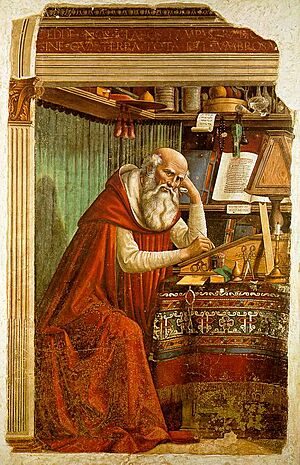
Jerome was born Eusebius Sophronius Hieronymus around 342–347 AD. He was from a group of people called the Illyrians. He was not baptized (a Christian ceremony) until he was about 18-27 years old. This happened in Rome, where he had gone with his friend Bonosus of Sardica. In Rome, he studied rhetoric (the art of speaking and writing well) and philosophy (the study of knowledge and existence). He learned Latin and some Greek from a teacher named Aelius Donatus.
Becoming a Christian
At first, Jerome was a bit afraid of Christianity. But eventually, he decided to become a Christian.
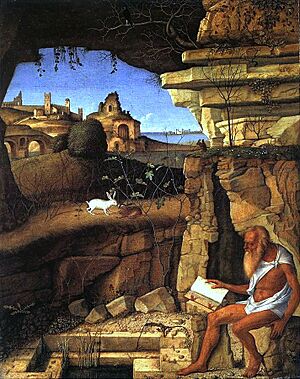
Jerome wanted to live a simple, strict life focused on his faith. So, he went to the desert of Chalcis, near Antioch. This area was known as the "Syrian Thebaid" because many holy people lived there. During this time, he studied and wrote a lot. He started learning Hebrew from a Jewish person who had become a Christian. He also copied parts of a Hebrew Gospel, which is now known as the Gospel of the Hebrews. Jerome translated parts of this Hebrew Gospel into Greek.
Working in Rome
Jerome became an important helper to Pope Damasus I in Rome. The Pope gave him tasks, including updating the older Latin versions of the New Testament. He used Greek manuscripts to make these corrections. He also updated the Book of Psalms that was used in Rome, basing it on the Septuagint (an old Greek translation of the Old Testament).
Important Scholarly Works
Translating the Bible (382–405)
Jerome finished his Bible translation while living in a monastery in Bethlehem. He started in 382 by fixing the existing Latin version of the New Testament, called the Vetus Latina. By 390, he began translating the Hebrew Bible directly from the original Hebrew. He finished this huge project by 405.
Before Jerome's translation (the Vulgate), all Latin translations of the Old Testament were based on the Septuagint. Jerome chose to use the Hebrew text instead, which was a new idea. Many other Christians, including Augustine, believed the Septuagint was inspired by God. But Jerome felt it was important to go back to the original Hebrew.
Bible Commentaries (405–420)
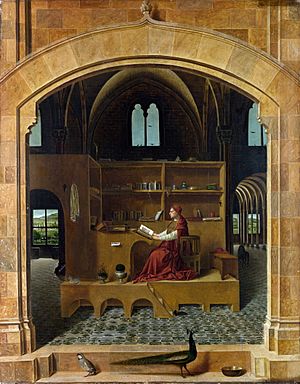
For the next 15 years, until he died, Jerome wrote many commentaries on the Bible. In these writings, he often explained why he chose certain words in his translation. He believed it was best to use the original Hebrew texts rather than older translations that might have mistakes.
Jerome in Art
Jerome is often shown with a lion. This comes from a popular story that he once tamed a lion in the wilderness by healing its injured paw. This story might have come from an older Roman tale about a man named Androcles.
From the Middle Ages onwards, artists often showed Jerome in different settings. He might be in his study, surrounded by books and writing tools. Or he might be in a rocky desert. Sometimes, he is shown studying a book in a cave. His study is often shown as large and full of books, and he is usually clean-shaven and well-dressed. A cardinal's hat (a symbol of high rank in the church) might also appear. These images show him as a serious scholar. The lion, often smaller, might be next to him in either setting.
Jerome is also sometimes shown with an owl, which is a symbol of wisdom and learning. Writing tools and a trumpet (symbolizing the final judgment) are also part of his common images.
A large limestone statue of Jerome was placed above the entrance of O’Shaughnessy Library at the University of St. Thomas in Minnesota in 1950. The sculptor was Joseph Kiselewski.
Images for kids
-
Jerome in the desert, tormented by his memories of the dancing girls, by Francisco de Zurbarán, 1639, Monastery of Santa María de Guadalupe
-
Saint Jerome by Matthias Stom, 1635
-
Francesco St Jerome by Jacopo Palma il Giovane, c. 1595
-
The Virgin and Child with Saints Jerome and Nicholas of Tolentino by Lorenzo Lotto, 1522
-
Saint Jerome in the Wilderness, Leonardo da Vinci, 1480–1490, Vatican Museums
-
Jerome Penitent in the Wilderness. Copper engraving, Albrecht Dürer 1494–1498
-
Hieronymus in Gehäus. Copper engraving, Albrecht Dürer 1514
-
Saint Jerome in the Wilderness by Lucas Cranach the Elder c. 1515
-
Saint Jerome in his study, c. 1530 by Pieter Coecke van Aelst and Workshop, Walters Art Museum
-
Saint Jerome and the Paulines painted by Gabriel Thaller in the St. Jerome Church in Štrigova, Međimurje County, northern Croatia (18th century)
See also
 In Spanish: Jerónimo (santo) para niños
In Spanish: Jerónimo (santo) para niños
- Androcles
- Bible translations
- Church Fathers
- Eusebius of Cremona
- Ferdinand Cavallera
- Genesius of Arles
- International Translation Day
- Letter of Jerome to Pope Damasus
- Order of St. Jerome
- Prologus Galeatus
- Pelagius
- Synod of Diospolis


